In 1959 Alexander Girard was commissioned to design the interior of the New York restaurant La Fonda del Sol, a commission for which Charles and Ray Eames designed the seating.
Yet whereas the La Fonda dining chair and La Fonda side chair are well-known, if currently out of production, components of the Eames' canon, what of the La Fonda bar stool.......
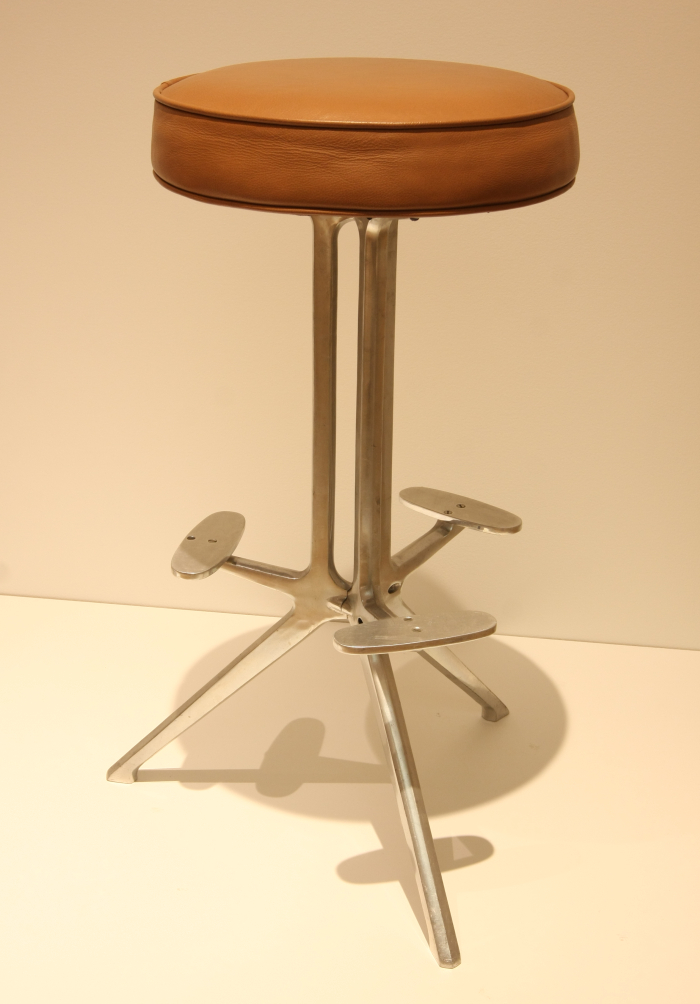
Housed on the ground floor of the, then, new Time & Life building on Manhattan's Rockefeller Platz, a building for whom Charles and Ray Eames designed three lobbies1, a project which saw them develop the eponymous Lobby Chair as a fusion of their Lounge Chair and Aluminium chairs, and also develop a family of walnut stools-cum-side-tables2, La Fonda del Sol was conceived as a Central and South American themed restaurant, a restaurant which sought to bring not only the foods and flavours and spices of Central and South America3 to New York, but the ambiance, the, if one so will, flair of Central and South America. And while, inarguably, employing a Central and/or South American designer to create the interior of a Central and South American themed restaurant would today be the first choice option, in late 1950s/early 1960s America such an option didn't exist, wasn't possible. How would you reach it? There being as there was no social or cultural basis on which such an option could be understood or such a decision approached.4
And so La Fonda del Sol's operator, Restaurant Associates, a company founded in 1947, who in 1957 had opened their first themed restaurant5, The Forum of the Twelve Caesars, yes an Ancient Rome themed restaurant6, and a company who today are responsible for managing and running the dining and catering facilities at a great many museums and public buildings, but at no Roman Fora, commissioned Alexander Girard with the interior design: and thus a creative who, inarguably as no other at that period, or arguably since, had found his calling, and his passion, in the study of global folk art. A creative who, along with his wife Susan, began collecting Mexican folk art in the late 1930s, a collection which by the time it was donated to the State of New Mexico in 1978 encompassed over 100,000 items acquired on innumerable trips and study tours to all corners of the globe; a creative who Charles Eames once described as being "part Magpie"7; a creative who once opined "Folk Art tells us there are no 'foreigners'. Their colors vary, their languages vary, but their spirits and aspirations are interwoven into one incredible rich humanity".8 And a creative who, together with Susan, and Lee Jaffe, Restaurant Associates' Vice President responsible for design and non-food purchasing, spent seven weeks visiting twelve Central and South American nations in search of ideas, and objects, for the interior of La Fonda del Sol.9 Which genuinely doesn't sound like a bad gig.
A trip, and a thereby accrued collection of objects and works by local artisans and artists, Girard combined with his decades of study of Central and South America, and decades of experience in interior design, to develop a concept for La Fonda del Sol which represented a theoretical, idealised, Latin American village plaza setting, a plaza setting with which, as contemporary critics opined, Girard created "the illusion that we are really out of doors"10, a setting that was "a revelation in the use of space, colour, pattern, form and accessories"11, where in addition to the 100s of sun images throughout the interior, accessories, uniforms and fittings, "the sun is in evidence in subtler ways, in the whole atmosphere of the place, in the colours, in the airy and open plan"12 a space that was "a vast mosaic of colour"13 where "the decor refreshes tired psyches, banishes belligerent reactions and sets digestive juices harmoniously aflow".14 And as one critic opined represented "the best example of interior design in Manhattan" in 1960.15 A colourfully, sunny, Latin American village plaza where "the doorman wears a handsome poncho emblazoned with a golden sun. The waiters wear gaucho jackets, each of which boats 420 buttons"16 while "the 'tortilleras (serving maids) ... wear colourful native dresses in red, orange, yellow and fuchsia cotton prints."17
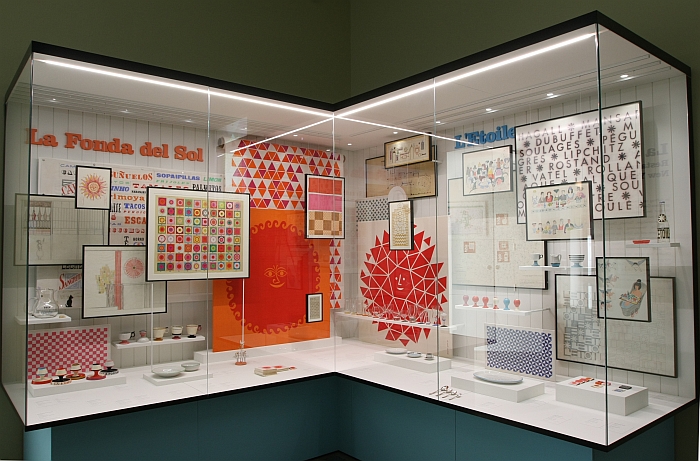
A restaurant which, yes, did openly play with a few easy cliches of Central and South America, not least, we'd argue, through the Fiesta that was held every Sunday, an event involving "strolling minstrels, hat dancers, guitar trios and [a] Mariachi band"18; but as Alexander Girard opined "La Fonda del Sol, in its totality, is an abstract symbol of Latin America, a special 'stage world' and not a historically or realistically accurate reproduction of any given place or proto-type".19 'Twas a themed restaurant. Not a documentary. Was meant to be authentic20 but not authoritative. A themed restaurant for a contemporary North America clientele. A themed restaurant authored by Girard employing Central and South American materials, practices and traditions, employing Central and South American objects purchased by Girard from their makers in their workshops, if presented in connections and contexts that were authored, wouldn't necessarily have made sense to those makers.
A themed restaurant authored by Girard as a Gesamtkunstwerk; Girard designing everything from napkins and crockery over uniforms and decoration and on to the fonts and identity.
A themed restaurant in whose realisation Restaurant Associates invested some $2,000,00021, which sounds a lot in 2022 and sounds an immense, extreme, sum in 1958-60; whereby we do hope a goodly amount of that money went to Central and South American creatives.
A themed restaurant which closed in 1971.
And a themed restaurant which isn't our focus here.
Our focus here is that part of the La Fonda del Sol interior design not directly under Girard's authorship.
The seating.
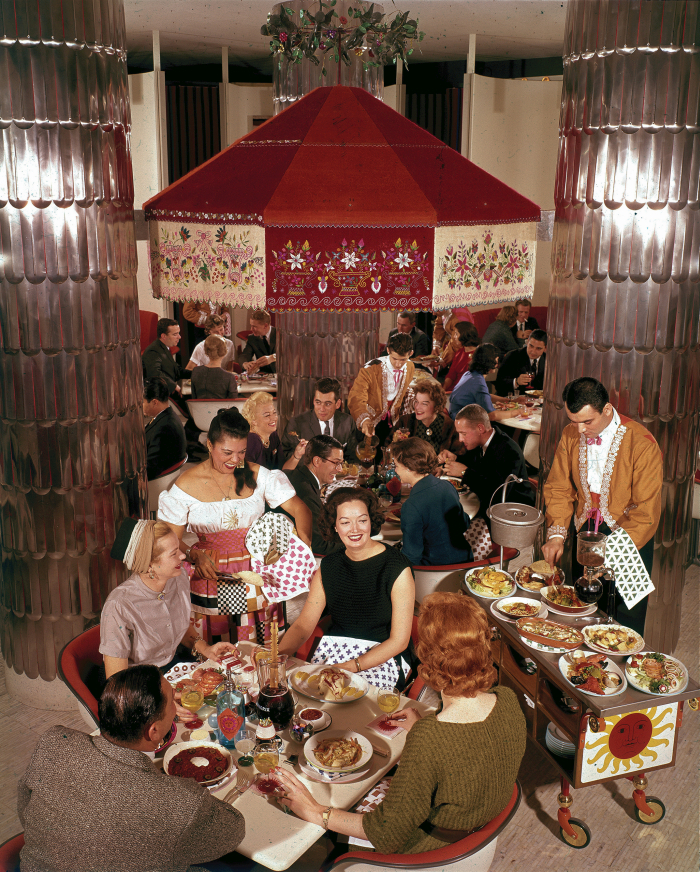
Much as today there would be a very convincing, unignorable, argument for commissioning designers from Central and South America to design the interior of a Central and South American themed restaurant, so with the furniture. However, as with the interior design, in late 1950s/early 1960s America such an option wasn't an option, simply couldn't be formulated. And that despite there being at that time numerous experienced and capable furniture designers in Central and South America; not least Clara Porset, a more than capable designer with experience in commissions for Central American hospitality settings aimed at a late 1950s North American clientele, and a designer well versed in developing contemporary interpretations of, and approaches to, traditional and vernacular furniture and processes. If a designer who in 1959 had travelled to Cuba to help Castro build his new socialist utopia and so who wouldn't, really, have been so readily available for Cold War America. Certainly wouldn't have been helpful in the marketing of La Fonda del Sol.
But, in any case, commissioning a Central or South American designer was impossible in late 1950s North America; and so Girard turned to his old friends Charles and Ray Eames.
And while both very much North America, Charles did, in many regards, have an epiphany moment, did begin a change of direction from his past existence to his coming existence, while spending some 9 months wandering, penny-less, through northern Mexico during the early 1930s, living amongst rural Mexicans, exchanging his manual labour, and his artworks, for food and board as he travelled, and getting to know parts of the country and some of its inhabitants. And studying the arts and cultures and traditions as he travelled.22 But wasn't actually Mexican.
But nor did Charles and Ray attempt to produce anything "Mexican", or otherwise inspired by, or by way of paying homage to, Central and South America, didn't attempt to produce a late 1950s North American view of Central and South American furniture.
Thankfully, the world cries in unison.
Although, we'd argue the risk they would have was very low, such wouldn't really have been in keeping with the Eames' approach to and positions to furniture and furniture design, wasn't really how they ticked. For all that they may, we'd argue did, have an affinity with Central America and its peoples, they were very much designers of industrial North America.
As were/are the La Fonda chairs.
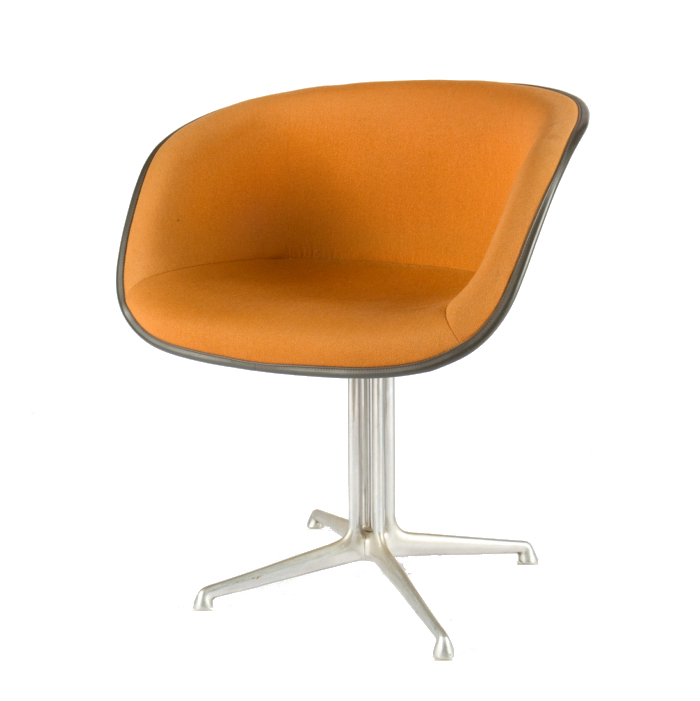
For La Fonda del Sol Alexander Girard stipulated he wanted chairs whose backs didn't extend above the tables, as this, according to Girard, would have disrupted the view of the space, not enabled the whole spectacle to have been savoured with the eyes. To this end Charles and Ray reworked their 1950/53 fibreglass A and S shells: with the A shell they, essentially, sliced off the clover leaf-esque lobe that rises from the back, and with the S shell they reduced the length of the backrest without altering the length of the seat and thereby creating an object with a wonderfully singular, and not unappealing, formal expression.
But that was just the start, just that undertaken to meet Girard's request.
For if there was one thing Charles and Ray enjoyed it was revisiting and developing their works, continually trying to improve on that which was; an Eames' product rarely being a destination, invariably being but a station on a journey.
Thus the Eames took the opportunity afforded by the La Fonda commission to develop a new base construction, and a new form of upholstery.
Or more accurately Don Albinson, that long serving, and equally long popularly undervalued, but absolute core, member of the Eames Office team, developed, along with Royce G. Engel Jr., a new upholstery system, specifically "an upholstery assembly with a protective decorative edge strip" for use on "preformed chair shells"23. An upholstery assembly that provided for a more secure and durable attachment of a protective edge strip to, and thereby a more durable upholstering of, "preformed contour" shells than had previously been possible, "preformed contour" shells that not least thanks to the work of Charles and Ray Eames or Eero Saarinen became a thing in the course of the 1950s; and a protective decorative edge that on the one hand prevented damage to the upholstery through regular, rough, handling, on the other hand helped limit damage to walls through upholstered seat shells rubbing against them, and on the rare, and thus all the more valuable third hand, allowed for a prominent rubber edge tracing and defining the silhouette of the now unseen shell, and which with its ego free, utilitarian, self-assurance came to define not only the image of the La Fonda chairs, but subsequently all upholstered Eames plastic shell chairs.
If an upholstery system which unlike the, so-called, bikini covers developed a few years earlier for the metal wire chairs wasn't removable/exchangeable; but did allow for an increased robustness of the upholstery, something of particular value in a high-intensity contract setting such as a 400+ seat downtown Manhattan restaurant. Thoughts which remind us that the function of an object is always a question of perspective, and rarely, ¿never? expressed in the singular, but invariably in the plural, and that a designer must be aware of all the functions of an object if the project is to be a success.
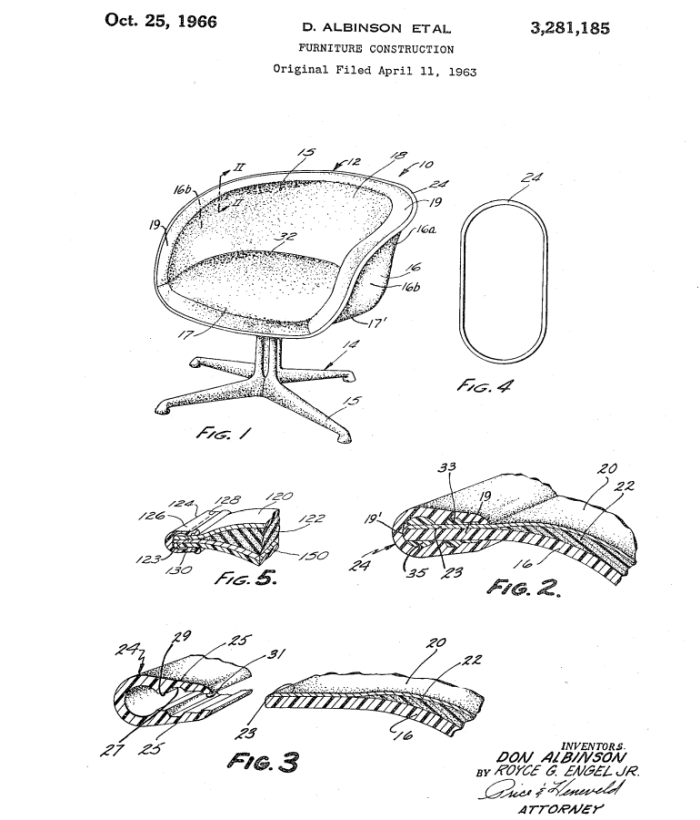
For the base of the La Fonda chair Charles and Ray re-imagined their so-called contract base, a four or five footed base as perhaps best exemplified in the chairs of the aluminium series, or the eponymous Lounge Chair, and took as their starting point, as Jolanthe Kugler neatly elucidates24, a base form initially employed in their entry for the 1948 MoMA International Competition for Low-cost Furniture Design, that project which gave rise, eventually, to the fibreglass shells; but which in La Fonda was fundamentally refined.25
Constructed from two mirror-imaged cast aluminium forms26, the La Fonda base expresses itself as a very elegant construction whose defining feature is four lightly ovoidal columns rising like pairs of fibulas and tibulas, or ulnas and radii, if arms are more your thing, and which bequeath the La Fonda base a heavy duty lightness, a graceful, quiet, rigidity. And which Olga Gueft opined gave the La Fonda chairs "the unmistakable impression of birds perched on one foot"27: ¿the La Fonda as figurative flamingos populating an imagined Latin American village? If a base which although later employed in a revised form to create the so-called La Fonda table, and being joined with a regular Eames' A shell by Vitra to create the Vitra DAL, didn't succeed in finding a widespread, general, utilisation in the Eames' canon. Which always strikes us a shame, for it is a most engaging of structures.
Thus, a project, chairs, whose simplified, industrial, production process from contemporary materials, it's inventive new upholstery concept, and its genesis in a re-imagining and re-working of existing projects, makes it a project that sits very nicely in the Eames' canon, are very much chairs that can help explain not only how the Eames' worked, but why.
And a project that was very much of late 1950s America. And not of some generic Latin America frozen in an undefined period that had never existed.
Or put another way, while the foods and flavours and spices and flair of La Fonda del Sol were authentic28 Central and South American, the chairs were authentic North American; while the foods and flavours and spices and flair transported you to Buenos Aires, Lima, Rio de Janeiro or Mexico City, your seat kept you firmly in New York City.
But, again, our focus here isn't the much discussed and admired La Fonda chairs, but the lesser spotted La Fonda del Sol bar stool.
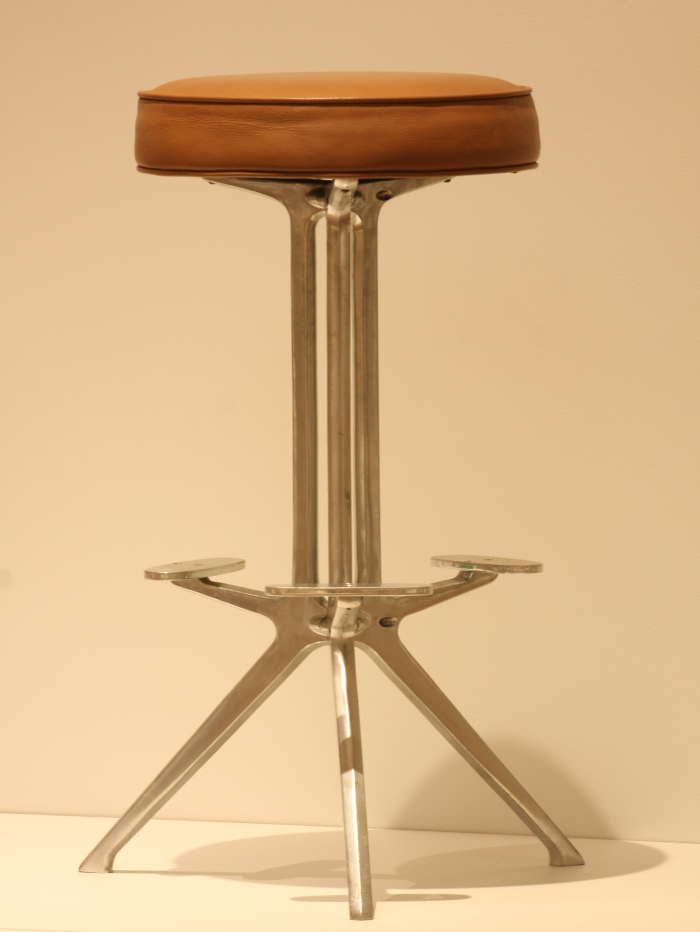
Whereby, we don't actually have any evidence it was ever used in La Fonda del Sol.
Not only can we find no mention of the La Fonda bar stool in the many and heavy Eames furniture books, but we can't find any photos of a bar stool in La Fonda del Sol, have no actual evidence of bar stools ever being present in La Fonda del Sol. The La Fond del Sol bar was however sited inside an adobe hut, or at least an authored Girard adobe hut sited in downtown Manhattan, with two narrow, single door, side entrances; thus the bar wasn't on public display and consequently in most photos only the exterior walls are visible, exterior walls which house display cases full of some of the objects the Girards had collected during their seven week tour of Central and South America. There are however a couple of photos of the adobe hut interior, or at least parts of the interior: in Interiors magazine there is a photo in which one can see part of the bar through an entrance29, while in Architectural Record there is a shot from outside the adobe hut which shows the full length of the bar.30
But no bar stools.
Which doesn't mean there weren't any; we can well imagine that they were removed to allow the red Mexican floor tiling and Brazilian Jacaranda wood detailing of the bar to be more visible, more prominent, the focus. It's the sort of thing photographers would do, especially in context of a commission by a restaurant operator designed to promote their (very expensively realised and heavily PR supported) restaurant; in such a small space bar stools would have taken up way too much room, and possibly caused problems with light: and so take them out. They're only stools!! And thus we like to imagine, hang on to the thread of hope, that the bar stools are are standing tantalisingly just out of sight.
For we do believe they were there. Have just been forgotten. And thus become lost.
They were certainly produced by Herman Miller around 1960 and are unmistakably La Fonda.31
Why else would they have been produced, if not for La Fonda del Sol?
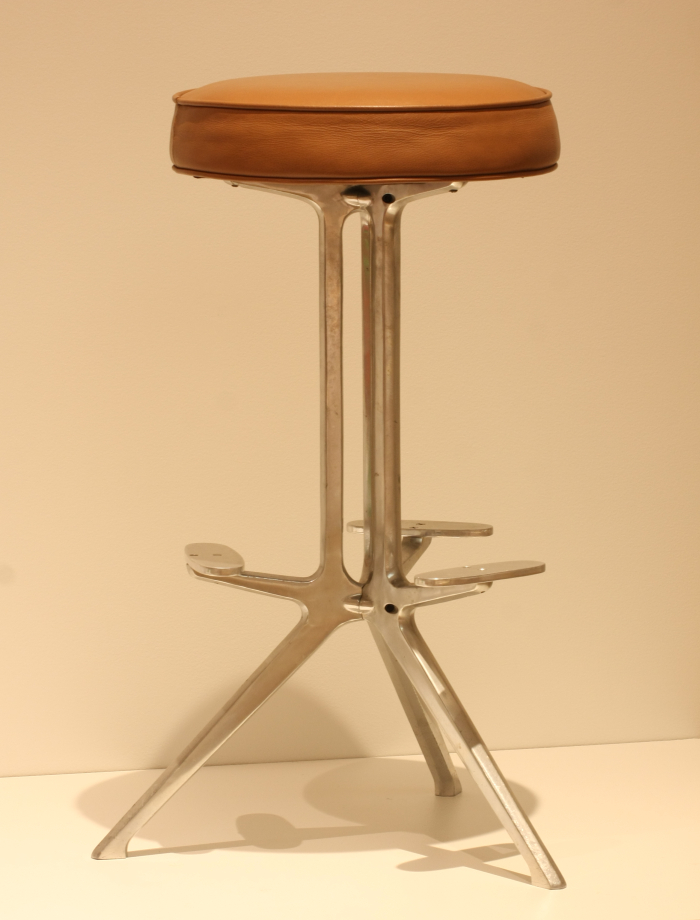
The principle difference between the La Fonda chairs and the La Fonda bar stools, apart from the height, the latter being three-legged rather than four, one presumes, on account of stability, and in the utilisation for the base of the bar stool three identical components rather than two mirrored components, thus representing an optimisation of the process and construction over the La Fonda chair base, is the decision to use a simple leather upholstered button seat rather than a fibreglass shell.
Thankfully, the world, again, cries in unison.
Can you imagine! It would have been awful!
And not just formally.
It's a bar stool for a small space, the simple leather upholstered button seat keeps it discreet. It's a bar stool for a space where the furniture shouldn't distract from the concept, the simple leather upholstered button seat complies with that request. It's a bar stool in a country, a city, in which counter stools in Diners are known, had been known for decades, for their simple button seats, the simple leather upholstered button seat echoes that and reminds you where you are, reminds you that you are in New York dining establishment, not in an adobe hut in Latin America. It's a bar stool: the simple leather upholstered button seat confirms that.
A simple leather upholstered button seat that doesn't feature anywhere else in the Eames' canon, but then neither do bar stools. Or indeed stools in general, for all their fame as furniture designers the Eames' canon is relatively restricted in terms of furniture genres; and that not least because as a canon it is primarily about the hows and wherefores and less the whats that arose. The Eames weren't about collecting of commissions and a ticking of boxes, but about designing furniture for contemprory society and industry.
And a simple leather upholstered button seat that allows the focus to be on the base.
And for all on the ever joyous footrests.
Footrests that, without question are the La Fonda bar stool's defining feature. And highlight.
Whereas bar stool footrests are invariably the stretchers between the legs, an external circumferencing ring or a squashed semi-circular brace construction, that latter often giving the impression of being an apologetic afterthought, Charles and Ray appear to have added stirrup irons to theirs; which we'd love to claim was inspired by considerations of the riding position Goethe adopted on his 18th century standing height stool, on his donkey, but can't.
Or possibly not stirrups, although they do very much remind of stirrups, but, potentially, some footrest from a motorbike, or a step used to access a locomotive, or a crane or a ship or some other vehicle or industrial machine; for they very much have something of the existing product about them, very much give the impression of being a re-appropriated off-the-shelf solution. Which, again, is very much a Charles and Ray thing: using existing goods for new purposes. Their house, for example in Pacific Palisades, Los Angeles, was largely constructed from off-the-shelf products, as was the, so-called, Galaxy, the Eames Office's singular foray into the world of lamp design.32 For industrial Modernists Charles and Ray were very bricolage Postmodern.
But wherever they came from the La Fonda bar stool footrests are just an utter, and unending, joy.
As is the way they grow out of the node in the leg; from that point from where the old, straight and true, growth above, bursts forth anew in two new directions to create a very organic branching construction where the acute angles above and below the footrest branch exist in a very nice correlation not only to one another but also to the obtuse burst of the new growth the leg takes. For all that it they are industrially crafted from cast aluminium they could also be the natural consequence of a living, growing material; and as a work the La Fonda bar stool would have been very much at home in Mimesis. A Living Design at the Centre Pompidou-Metz.
And were the footrests not there, it would a ghastly mundane bar stool. How would you otherwise bring the legs to the floor in an aesthetically pleasing manner, in a manner that was meaningful and allowed you to build a relationship with the work? Thus the footrests are not just functionally important, but formally important. One could almost argue that function follows form, that one needed the growth that leads to the footrest and so added a footrest.
While the use of three single footrests rather than an external ring helps keep the structure open, complimenting, supporting, enhancing the gaps between the columns; an openness which a ring would have closed, delineated, offended. And looked like an emergency solution. Would have been as awful as placing a A or S shell atop. Imagine!!
In addition the single footrests, stirrups, are very much an invitation to perch; one foot on a footrest the other on the floor; bar stools all too often demand that you sit fully on them, which tends to move you further away from others, make you more remote. Which isn't necessarily how you want to be in a bar in a social context. The footrest is much freer, more casual.
And thus a combination of construction principles, formal solutions, and intuitive usability, and stirrups, that allow for a most pleasing and satisfying and communicative bar stool.
An bar stool which although part of a family, is very much an individual, with its own expression and interpretation of that shared genealogy, one that extends the family tradition rather than maintaining it.
A bar stool that is as engaging and alluring and contemporary today as it was, must have been, in 1960.
A bar stool by Charles and Ray Eames that as an expression of the positions and approaches of Charles and Ray Eames can help one develop more nuanced appreciations of Charles and Ray Eames.
And a bar stool by Charles and Ray Eames that has completely vanished.
1John Neuhart, Marilyn Neuhart & Ray Eames, Eames Design. The work of the office of Charles and Ray, Ernst & Sohn 1989, page 247
2ibid page 249 states that the wooden stools/tables were Ray's work.
3By all accounts La Fonda del Sol was one of the first New York restaurants to offer Central/South American rotisserie and churrascaria. And similarly is regularly held up as being the first Central/South American restaurant in New York; whereby we imagine there were Central and Southern American eateries in 1950s New York. We don't know, we weren't there, but would imagine there would have been some. If arguably at the cheaper end and in neighbourhoods where polite New York society didn't really venture, it being as it was too real. But that's a subject for others.
4The staff do appear to have primarily been South and Central Americans, apparently from 23 nations
5The themed restaurant was, by all accounts, very much a thing in 1960s America, and by 1964 Restaurant Associates offered diners a near world tour, and time travel, without leaving New York, having restaurants that, as The New Yorker noted, beyond Ancient Roman offered diners "Latin-American, Polynesian, Indonesian, French, Italian, German, and nineteenth-, eighteenth-, and seventeenth-century English" cuisine see Geoffrey T. Hellman, Profile. Directed to the Product, The New Yorker, October 17th 1964, page 59
6For all keen to know how an ancient Roman would have eaten in late 1950s New York, a Forum of the Twelve Caesars menus is joyously available online through New York Public Libraries https://digitalcollections.nypl.org/items/5e66b3e8-9748-d471-e040-e00a180654d7 (accessed 07.11.2022)
7Letter from Charles Eames to Walter McQuade, 26.12.1956. As displayed in Alexander Girard A Designer’s Universe, Vitra Design Museum. Weil am Rhein, 12.03.2016 – 22.01.2017
8Alexander Girard in Sarah Nestor [Ed.] Multiple Visions: A Common Bond. The Girard Foundation Collection, Museum of International Folk Art, Museum of New Mexico, Sante Fe, 1982
9see Barbara Hauß, Designing for Dining: Restaurants von Alexander Girard in Mateo Kries & Jochen Eisenbrand [Eds.], Alexander Girard: A designer's universe, Vitra Design Museum, 2016 The search for suitable foods and recipes was, by all accounts equally as time and travel intensive. As a restaurant La Fonda del Sol definitely wasn't thrown together, which also helps explain the price tag.......
10Olga Gueft, The Inn of the Sun, Interiors, February 1961, page 90
11Harriet Morrison, A Cluttered Cave is '61 Design for Living, New York Herald Tribune, January 3rd 1961
12Interior designed by Alexander Girard for the Inn of the Sun, Architectural Record, June 1961
13Craig Clairborxe, 3 city restaurants boast dramatic new interiors, New York Times, September 22nd 1960
14Olga Gueft, The Inn of the Sun, Interiors, February 1961, page 90
15Harriet Morrison, A Cluttered Cave is '61 Design for Living, New York Herald Tribune, January 3rd 1961
16Ann Adam, Today's Food: Delicious gaucho beef stew makes spicy addition to menu, The Globe and Mail, October 4th 1960
17Elinor Lee, Fish was bait: Pescado con frutas a la argentina, The Washington Post, October 3rd 1960
18Undated newspaper advert for La Fonda del Sol, reprinted in Restaurant Associates in Ben Rosen, The Corporate Search for Visual Identity, Van Nostrand Reinhold Company 1970
19Unreferenced quote in Todd Oldham & Keira Coffee, Alexander Girard, AMMO 2011
20Authentic is a very awkward word, arguably a state that can only exist in a transient, unconscious moment, but just this once let us all assume its dictionary definable, a definitive reality and something one can approach.......
21see Geoffrey T. Hellman, Profile. Directed to the Product, The New Yorker, October 17th 1964, page 86
22see, for example, From Mexico to Cranbrook in Eames Demetrios, An Eames Primer, Thames & Hudson 2001. Demetrios notes that Charles spent "eight or ten months in Mexico", while in Virginia Stith, St Louis Oral History Project, Interview with Charles Eames October 13th 1977, reproduced in Daniel Ostroff [Ed] An Eames Anthology, Yale University Press, 2015 Charles states in almost the same breath that he was in Mexico "for almost a year" and "about eight months". We've averaged that to all ca. 9. Nobody really knows how long.......
23see US Patent 3,281,185 Furniture Construction, D. Albinson et al, October 25th 1966
24see Mateo Kries and Jolanthe Kugler, Eames Furniture Sourcebook, Vitra Design Museum, 2017, page 176ff
25ibid page 217 has a comparison of the 1948 and the 1960 constructions.
26We admittedly haven't seen a La Fonda chair for a while, and our memory is that it is two mirror imaged parts, and that is how Eames Office, i.e. the Eames estate, describe things. However we've very recently seen a few photos that imply it was two different components. The crux is that the support under the seat shell has four fingers, two long and two short, and thus you can either cast a single component with one long and one short finger, or two components each with either two long fingers or two short fingers. And some photos we've seen of late appear to show one mirrored element, and others two different. Which may indicate there was a switch at some stage. Particularly confusing is the situation as depicted in the Vitra Design Museum's Eames Furniture Sourcebook, on page 177 is a photo which appears to show two different components, while on 179 is photo that appears to show two identical pieces, but apparently on the same chair, which obviously makes no sense..... We still assume it it is two mirror image components, but are no longer 100% certain. Yes we could have, should have, have tried to find an answer, but we wanted to get this post out, the confusion came as we were essentially finished. And it's not that relevant, our focus is the bar stool. We will research further and update once, if, we have confirmed answer.....
27Olga Gueft, The Inn of the Sun, Interiors, February 1961, page 90
28see FN 20
29Olga Gueft, The Inn of the Sun, Interiors, February 1961
30Interior designed by Alexander Girard for the Inn of the Sun, Architectural Record, June 1961
31The only example of the bar stool we know of is in Grand Rapids Art Museum, Michigan, where it is listed as "Gift of Herman Miller", and one must assume that Herman Miller know what they are talking about, and are certain that it is by Charles and Ray, from ca. 1960 and for La Fonda. The full story is undoubtedly slumbering in Herman Miller's extensive archive, waiting to be rediscovered. As, we'd argue, is the bar stool.......
32Galaxy was apparently the work of Don Albinson an, as noted elsewhere in this post and these dispatches, absolute key player in the Eames Office, but for rhetoric reasons we mention it at this position as Eames Office. Plus Charles and Ray would have known what was being done, and in all probability would have been involved in discussions on the genesis and development of the object and approved the bricolage approach. For more on Galaxy see John Neuhart, Marilyn Neuhart & Ray Eames, Eames Design, The work of the office of Charles and Ray Eames, Ernst & Sohn, 1989, page 125
Impossible as that may seem.......